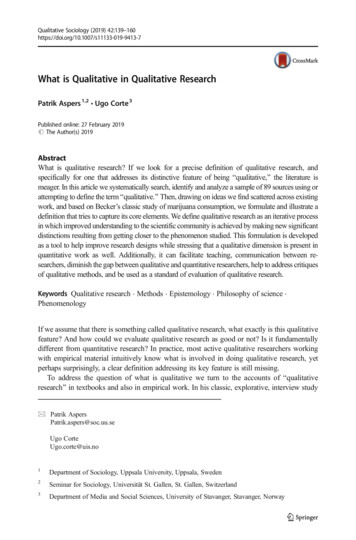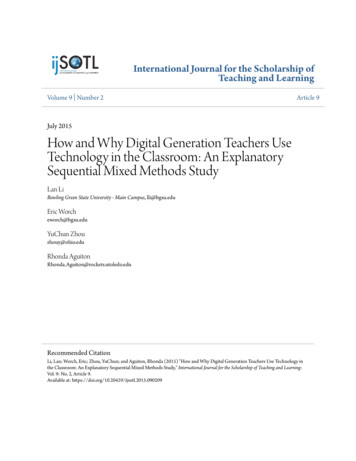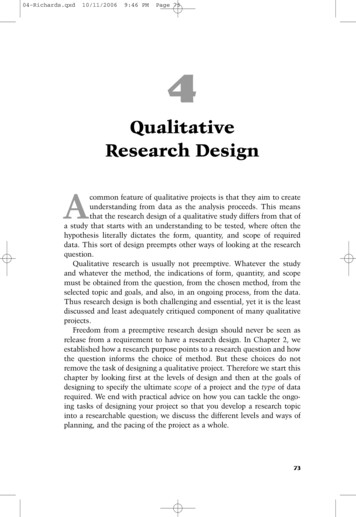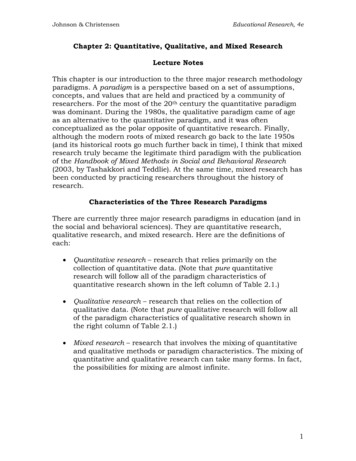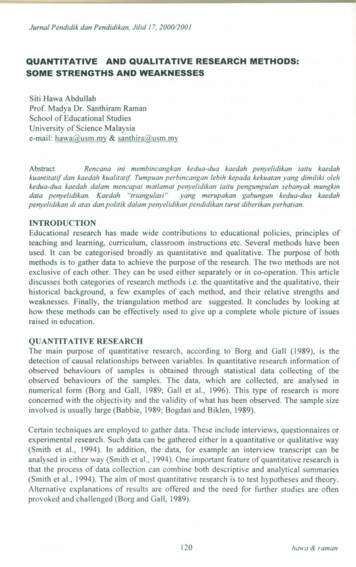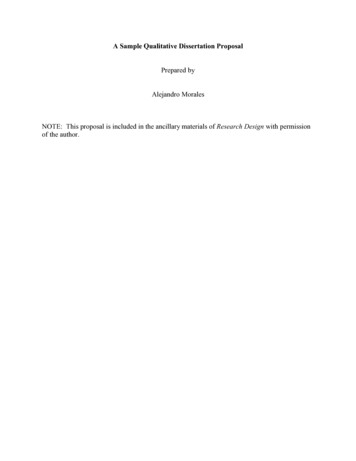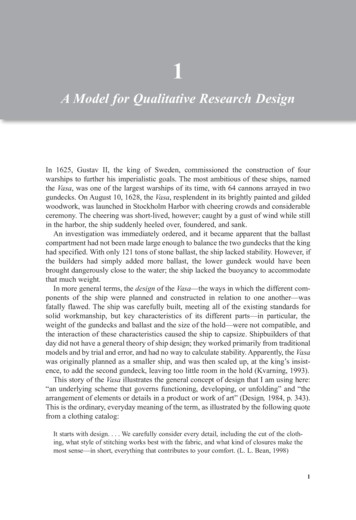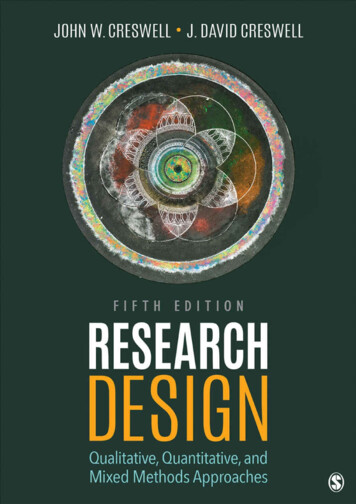
Transcription
Research DesignFifth Edition2
I dedicate this book to all of my mentees and former students over the years who have engaged in this fascinatingprocess of research and who have welcomed my suggestions for improving their scholarly works. I also welcome my son,J. David Creswell, a noted psychologist and researcher at Carnegie Mellon University, as my coauthor.3
Research DesignQualitative, Quantitative, and Mixed Methods ApproachesFifth EditionJohn W. CreswellDepartment of Family Medicine University of MichiganJ. David CreswellDepartment of Psychology Carnegie Mellon University4
FOR INFORMATION:SAGE Publications, Inc.2455 Teller RoadThousand Oaks, California 91320E-mail: order@sagepub.comSAGE Publications Ltd.1 Oliver’s Yard55 City RoadLondon EC1Y 1SPUnited KingdomSAGE Publications India Pvt. Ltd.B 1/I 1 Mohan Cooperative Industrial AreaMathura Road, New Delhi 110 044IndiaSAGE Publications Asia-Pacific Pte. Ltd.3 Church Street#10-04 Samsung HubSingapore 049483Copyright 2018 by SAGE Publications, Inc.All rights reserved. No part of this book may be reproduced or utilized in any form or by any means,electronic or mechanical, including photocopying, recording, or by any information storage and retrievalsystem, without permission in writing from the publisher.Printed in the United States of AmericaLibrary of Congress Cataloging-in-Publication DataNames: Creswell, John W., author. Creswell, J. David, author.Title: Research design : qualitative, quantitative, and mixed methods approaches / John W. Creswell, PhD, Department of Family Medicine,University of Michigan, and J. David Creswell, PhD, Department of Psychology, Carnegie Mellon University.Description: Fifth edition. Los Angeles : SAGE, [2018] Includes bibliographical references and index.5
Identifiers: LCCN 2017044644 ISBN 978-1-5063-8670-6 (pbk. : alk. paper)Subjects: LCSH: Social sciences—Research—Methodology. Social sciences—Statistical methods.Classification: LCC H62 .C6963 2018 DDC 300.72/1—dc23 LC record available at https://lccn.loc.gov/2017044644Acquisitions Editor: Helen SalmonContent Development Editor: Chelsea NeveEditorial Assistant: Megan O’HeffernanProduction Editor: David C. FeltsCopy Editor: Amy MarksTypesetter: C&M Digitals (P) Ltd.Proofreader: Eleni-Maria GeorgiouIndexer: Stepping Stones Indexing ServicesCover Designer: Janet KieselMarketing Manager: Shari Countryman6
Brief Contents1. Analytic Contents of Research Techniques2. Preface3. Companion Website4. Acknowledgments5. About the Authors6. Part I Preliminary Considerations1. Chapter 1 The Selection of a Research Approach2. Chapter 2 Review of the Literature3. Chapter 3 The Use of Theory4. Chapter 4 Writing Strategies and Ethical Considerations7. Part II Designing Research1. Chapter 5 The Introduction2. Chapter 6 The Purpose Statement3. Chapter 7 Research Questions and Hypotheses4. Chapter 8 Quantitative Methods5. Chapter 9 Qualitative Methods6. Chapter 10 Mixed Methods Procedures8. Glossary9. References10. Author Index11. Subject Index7
Detailed Contents1. Analytic Contents of Research Techniques2. Preface1. Purpose2. Audience3. Format4. Outline of Chapters3. Companion Website4. Acknowledgments5. About the Authors6. Part I Preliminary Considerations1. Chapter 1 The Selection of a Research Approach1. The Three Approaches to Research2. Three Components Involved in an Approach1. Philosophical Worldviews1. The Postpositivist Worldview2. The Constructivist Worldview3. The Transformative Worldview4. The Pragmatic Worldview2. Research Designs1. Quantitative Designs2. Qualitative Designs3. Mixed Methods Designs3. Research Methods3. Research Approaches as Worldviews, Designs, and Methods4. Criteria for Selecting a Research Approach1. The Research Problem and Questions2. Personal Experiences3. Audience5. Summary1. Writing Exercises6. Additional Readings2. Chapter 2 Review of the Literature1. The Research Topic2. The Literature Review1. The Use of the Literature2. Design Techniques1. Steps in Conducting a Literature Review8
2. Searching Computerized Databases3. A Priority for Selecting Literature Material4. A Literature Map of the Research5. Abstracting Studies3. Example 2.1. Literature Review Abstract in a Quantitative Study4. Example 2.2. Literature Review Abstract in a Study Advancing a Typology1. Style Manuals5. The Definition of Terms6. Example 2.3. Terms Defined in an Independent Variables Section7. Example 2.4. Terms Defined in a Mixed Methods Dissertation8. A Quantitative or Mixed Methods Literature Review3. Summary1. Writing Exercises4. Additional Readings3. Chapter 3 The Use of Theory1. Quantitative Theory Use1. Testing Causal Claims in Quantitative Research2. Variables in Quantitative Research3. Definition of a Theory in Quantitative Research4. Forms of Theories in Quantitative Research5. Placement of Quantitative Theories6. Writing a Quantitative Theoretical Perspective7. Example 3.1. A Quantitative Theory Section2. Qualitative Theory Use1. Variation in Theory Use in Qualitative Research2. Locating the Theory in Qualitative Research3. Example 3.2. A Theory Early in a Qualitative Study3. Mixed Methods Theory Use1. Example 3.3. A Theory at the End of a Qualitative Study2. Social Science Theory Use3. Participatory–Social Justice Theory Use4. Box 3.1. Transformative-Emancipatory Questions for Mixed Methods ResearchersThroughout the Research Process5. Example 3.4. Theory in a Feminist Mixed Methods Study4. Summary1. Writing Exercises5. Additional Readings4. Chapter 4 Writing Strategies and Ethical Considerations1. Writing the Proposal1. Arguments Presented in a Proposal9
2. Format for a Qualitative Proposal3. Example 4.1. A Qualitative Constructivist/Interpretivist Format4. Example 4.2. A Qualitative Participatory–Social Justice Format5. Format for a Quantitative Proposal6. Example 4.3. A Quantitative Format7. Format for a Mixed Methods Proposal8. Example 4.4. A Mixed Methods Format9. Designing the Sections of a Proposal2. Writing Ideas1. Writing as Thinking2. The Habit of Writing3. Readability of the Manuscript4. Example 4.5. An Illustration of the Hook-and-Eye Technique5. Voice, Tense, and “Fat”3. Ethical Issues to Anticipate1. Prior to Beginning the Study2. Beginning the Study3. Collecting the Data4. Analyzing the Data5. Reporting, Sharing, and Storing Data4. Summary1. Writing Exercises5. Additional Readings7. Part II Designing Research1. Chapter 5 The Introduction1. The Importance of Introductions2. An Abstract for a Study3. Qualitative, Quantitative, and Mixed Methods Introductions4. A Model for an Introduction1. An Illustration2. The Research Problem3. Studies Addressing the Problem4. Deficiencies in Past Literature5. Example 5.1. Deficiencies in the Literature—Needed Studies6. Example 5.2. Deficiencies in the Literature—Few Studies7. Significance of a Study for Audiences8. Example 5.3. Significance of the Study Stated in an Introduction to a QuantitativeStudy5. Summary1. Writing Exercises10
6. Additional Readings2. Chapter 6 The Purpose Statement1. Significance and Meaning of a Purpose Statement1. A Qualitative Purpose Statement2. Example 6.1. A Purpose Statement in a Qualitative Phenomenology Study3. Example 6.2. A Purpose Statement in a Case Study4. Example 6.3. A Purpose Statement in an Ethnography5. Example 6.4. A Purpose Statement in a Grounded Theory Study6. A Quantitative Purpose Statement7. Example 6.5. A Purpose Statement in a Published Survey Study8. Example 6.6. A Purpose Statement in a Dissertation Survey Study9. Example 6.7. A Purpose Statement in an Experimental Study10. A Mixed Methods Purpose Statement11. Example 6.8. A Convergent Mixed Methods Purpose Statement12. Example 6.9. An Explanatory Sequential Mixed Methods Purpose Statement13. Example 6.10. An Exploratory Sequential Mixed Methods Purpose Statement2. Summary1. Writing Exercises3. Additional Readings3. Chapter 7 Research Questions and Hypotheses1. Qualitative Research Questions1. Example 7.1. A Qualitative Central Question From an Ethnography2. Example 7.2. Qualitative Central Questions From a Case Study2. Quantitative Research Questions and Hypotheses1. Example 7.3. A Null Hypothesis2. Example 7.4. Directional Hypotheses3. Example 7.5. Nondirectional and Directional Hypotheses4. Example 7.6. Standard Use of Language in Hypotheses5. A Model for Descriptive Questions and Hypotheses6. Example 7.7. Descriptive and Inferential Questions3. Mixed Methods Research Questions and Hypotheses1. Example 7.8. Hypotheses and Research Questions in a Mixed Methods Study2. Example 7.9. A Mixed Methods Question Written Using Methods and ContentLanguage4. Summary1. Writing Exercises5. Additional Readings4. Chapter 8 Quantitative Methods1. Defining Surveys and Experiments2. Components of a Survey Study Method Plan11
1. The Survey Design2. The Population and Sample3. Instrumentation4. Variables in the Study5. Data Analysis6. Interpreting Results and Writing a Discussion Section7. Example 8.1. A Survey Method Plan3. Components of an Experimental Study Method Plan1. Participants2. Variables3. Instrumentation and Materials4. Experimental Procedures5. Example 8.2. Pre-experimental Designs6. Example 8.3. Quasi-experimental Designs7. Example 8.4. True Experimental Designs8. Example 8.5. Single-Subject Designs9. Threats to Validity10. The Procedure11. Data Analysis12. Interpreting Results and Writing a Discussion Section13. Example 8.6. An Experimental Method Plan4. Summary1. Writing Exercises5. Additional Readings5. Chapter 9 Qualitative Methods1. The Characteristics of Qualitative Research2. Qualitative Designs3. The Researcher’s Role and Reflexivity4. Data Collection Procedures5. Data Recording Procedures6. Data Analysis Procedures7. Interpretation8. Validity and Reliability9. Writing the Qualitative Report1. Example 9.1. Qualitative Procedures10. Summary1. Writing Exercises11. Additional Readings6. Chapter 10 Mixed Methods Procedures1. Components of Mixed Methods Procedures12
1. Describe Mixed Methods Research2. Types of Mixed Methods Designs1. Convergent Mixed Methods Design2. Explanatory Sequential Mixed Methods Design3. Exploratory Sequential Mixed Methods Design4. Several Complex Mixed Methods Designs3. A Procedure for Embedding Core Designs Into Complex Designs4. Factors Important in Choosing a Mixed Methods Design5. Examples of Mixed Methods Procedures1. Example 10.1. A Convergent Parallel Mixed Methods Design2. Example 10.2. An Explanatory Sequential Mixed Methods Design3. Example 10.3. An Exploratory Sequential Mixed Methods Design4. Example 10.4. A Social Justice Design6. Summary1. Writing Exercises7. Additional Readings8. Glossary9. References10. Author Index11. Subject Index13
Analytic Contents of Research Techniques14
Chapter 1. The Selection of a Research ApproachDetermining your research approachIdentifying a worldview with which you are most comfortableDefining the three types of research approachesUsing quantitative, qualitative, and mixed methods designs and methods15
Chapter 2. Review of the LiteratureAssessing whether your topic is researchableUsing steps in conducting a literature reviewUsing computerized databases available for reviewing the literatureDeveloping a priority for types of literature to reviewDesigning a literature mapWriting a good abstract of a research studyUsing important elements of a style manualDefining termsEmploying a model for writing a literature review16
Chapter 3. The Use of TheoryTesting causal claims in quantitative researchIdentifying variables in a quantitative studyDefining the nature of a quantitative theoryUsing a script to write a theoretical perspective into a quantitative studyConsidering the types of theories used in qualitative researchPlacing theories in a qualitative studyPlacing a theoretical lens into a mixed methods study17
Chapter 4. Writing Strategies and Ethical ConsiderationsAssessing the structure of a proposal for qualitative, quantitative, and mixed methods studiesUsing writing strategies for drafting a proposalDeveloping a habit of writingConstructing umbrella thoughts, big thoughts, little thoughts, and attention thoughts in writingDeveloping writing consistency through the hook-and-eye techniqueUsing principles of writing good proseAnticipating ethical issues in many phases of the research process18
Chapter 5. The IntroductionWriting an abstract for a studyExploring differences among quantitative, qualitative, and mixed methods introductionsUsing the deficiency model for writing an introductionDesigning a good narrative hookWriting about the research problemSummarizing the literature about a research problemPointing out deficiencies in past literatureConsidering audiences that may profit from your study19
Chapter 6. The Purpose StatementUsing a script for writing a qualitative purpose statementConsidering how the script would change depending on your qualitative designUsing a script for writing a quantitative purpose statementConsidering how the script would change depending on your quantitative designUsing a script for writing a mixed methods purpose statementConsidering how the script would change depending on your mixed methods design20
Chapter 7. Research Questions and HypothesesWriting a script for a qualitative central questionConsidering how this script would change depending on the qualitative designWriting a script for quantitative research questions and hypothesesConsidering how this script would change depending on the quantitative design and the different typesof hypothesesUsing a model for descriptive and inferential quantitative questions and hypothesesWriting scripts for different forms of research questions for a mixed methods study21
Chapter 8. Quantitative MethodsUsing a checklist for survey research to form topic sections of a survey procedureEmploying steps in analyzing data for a survey procedureWriting a complete survey methods discussionUsing a checklist for experimental research to form sections for an experimental procedureIdentifying the type of experimental procedure that best fits your proposed studyDrawing a diagram of experimental proceduresIdentifying the potential internal validity and external validity threats to your proposed study22
Chapter 9. Qualitative MethodsUsing a checklist for qualitative research to form topic sections of a procedureStating the basic characteristics of qualitative researchDetermining how reflexivity will be included in a proposed studyWeighing the different types of data collected in qualitative researchEmploying steps in the qualitative data analysis processEstablishing validity in qualitative research23
Chapter 10. Mixed Methods ProceduresStating a definition and the characteristics of mixed methods researchUsing a convergent mixed methods designUsing an explanatory sequential mixed methods designEmploying an exploratory sequential mixed methods designUsing one of the complex mixed methods designsChoosing which design is best for a mixed methods study24
Preface25
PurposeThis book advances a framework, a process, and compositional approaches for designing a proposal orresearch project for qualitative, quantitative, and mixed methods research in the human, health, and socialsciences. The ascendency of qualitative research, the emergence of mixed methods approaches, and the growthof quantitative designs have created a need for this book’s unique comparison of the three approaches toinquiry. This comparison begins with preliminary consideration of philosophical assumptions for all threeapproaches, a review of the literature, an assessment of the use of theory and conceptual frameworks inresearch approaches, and reflections about the importance of writing and ethics in scholarly inquiry. The bookthen addresses the key elements in the process of designing and conducting a research project: writing anintroduction; stating a purpose or research aims for the study; identifying research questions and hypotheses;and advancing methods and procedures for data collection, analysis, and interpretation. At each step in thisprocess, the reader is taken through qualitative, quantitative, and mixed methods approaches.26
AudienceThis book is intended for students and faculty who seek assistance in preparing a plan, proposal, or researchproject for a scholarly journal article, a dissertation, a thesis, or an application for funding. At a broader level,the book may be useful as both a reference book and a textbook for courses in research methods. To best takeadvantage of the design features in this book, the reader needs a basic familiarity with qualitative andquantitative research; however, terms will be explained and defined and recommended strategies advanced forthose needing introductory assistance in the design process. Highlighted terms in the text and a glossary of theterms at the back of the book provide a working language for understanding research. This book also isintended for a broad audience in the human, health, and social sciences. Readers’ comments from the pastfour editions suggest that individuals using the book come from many disciplines and fields. We hope thatresearchers in fields such as marketing, management, criminal justice, communication studies, psychology,sociology, K–12 education, higher and postsecondary education, nursing, family medicine, health servicesresearch, global health, behavioral health, urban studies, family research, and other fields of study will find thisfifth edition useful.27
FormatIn each chapter, we share examples drawn from varied disciplines. These examples are drawn from books,journal articles, dissertation proposals, and dissertations. Though our primary specialization is in educationalpsychology, the health sciences, and in psychology, the illustrations are intended to be inclusive of many fields.They reflect issues in social justice and examples of studies with marginalized individuals in our society as wellas the traditional samples and populations studied by researchers. Inclusiveness also extends to methodologicalpluralism in research today, and the discussion incorporates alternative philosophical ideas, diverse modes ofinquiry, and numerous procedures.This book is not a detailed method text; instead, we highlight the essential features of research design. Wehave attempted to reduce research to its essential core ideas so that researchers can plan a thorough andthoughtful study. The coverage of research designs is limited to frequently used forms: surveys andexperiments in quantitative research; narrative research, phenomenology, grounded theory, ethnography, andcase studies in qualitative research; and convergent, explanatory sequential, and exploratory sequential designsin mixed methods research. Although students preparing a dissertation proposal should find this book helpful,topics related to the politics of presenting and negotiating a study with review committees are addressedthoroughly in other texts.Consistent with accepted conventions of scholarly writing, we have tried to eliminate any words or examplesthat convey a discriminatory (e.g., sexist or ethnic) orientation. Examples were selected to provide a full rangeof gender and cultural orientations. Throughout the text we do not favor either qualitative or quantitativeresearch. Indeed, we have intentionally altered the order of qualitative and quantitative examples throughoutthe book. Readers should also note that in the longer examples cited in this book, many references are made toother writings. Only the reference to the work we use in the illustration will be cited, not the entire list ofreferences embedded within any particular example. As with earlier editions, we have maintained features toenhance the readability and understandability of the material: bullets to emphasize key points, numberedpoints to stress key steps in a process, and longer examples of complete passages with annotations to highlightkey research ideas that are being conveyed by the authors.In this fifth edition of the book, new features have been added in response to developments in research andreader feedback:In this edition, we shape the discussion not only around designing a proposal for a research project but alsoaround the steps in designing a research study. Thus, the emphasis on designing a research study (asopposed to focusing only on a proposal) is slightly larger for this edition than in past editions.We have added more information about the epistemological and ontological assumptions as they relateto research questions and methods.In the worldview section, we now include more on the transformative worldview.In the methods discussion, we have added more on specific approaches such as case studies,28
participatory action research, and visual methods in qualitative research.Also in the qualitative methods, we have added information about social media and online qualitativemethods. Also, we have added more information on memoing and on reflexivity.In the mixed methods, we now incorporate information about action research (participatory research)and program evaluation.In the respective methods chapters, we have included more on qualitative and quantitative data analysissoftware.In the theory section, we have added information about causality, and then incorporated its relationshipto statistics in the quantitative methods.For our quantitative, qualitative, and mixed methods sections, we have incorporated sections on writingdiscussion sections into each of these methodologies.We have incorporated new information into all of our methods chapters—quantitative, qualitative, andmixed methods. Our mixed methods chapter now reflects the latest advances in the field.Throughout the book, we have cited updated editions of research methods books that have emergedsince the last edition and added current references and additional readings.29
Outline of ChaptersThis book is divided into two parts. Part I consist of steps that researchers need to consider before they developtheir proposals or plans for research. Part II discusses the various sections used to develop a scholarly researchproposal for a thesis, dissertation, or a research report.30
Part I. Preliminary ConsiderationsThis part of the book discusses preparing for the design of a scholarly study. It contains Chapters 1 through 4.Chapter 1. The Selection of a Research ApproachIn this chapter, we begin by defining quantitative, qualitative, and mixed methods approaches. We thendiscuss how philosophy, designs, and methods intersect when one uses one of these approaches. We reviewdifferent philosophical stances; advanced types of qualitative, quantitative, and mixed methods designs; andthen discuss the methods associated with each design. We also consider the factors that go into the choice ofan approach to research. Thus, this chapter should help proposal developers decide whether a qualitative,quantitative, or mixed methods approach is suitable for their proposed research project.Chapter 2. Review of the LiteratureIt is important to extensively review the literature on your topic before you design your proposal. Thus, youneed to begin with a researchable topic and then explore the literature using the steps advanced in thischapter. This calls for setting a priority for selecting material from the literature, drawing a visual map ofstudies that relate to your topic, writing good abstracts, employing skills learned from using style manuals, anddefining key terms. This chapter should help researchers thoughtfully consider relevant literature on theirtopics and start compiling and writing literature reviews.Chapter 3. The Use of TheoryTheories serve different purposes in the three approaches inquiry. In quantitative research, they provide aproposed explanation for the relationship among variables being tested by the investigator. In qualitativeresearch, they may often serve as a lens for the inquiry or they may be generated during the study. In mixedmethods studies, researchers employ them in many ways, including those associated with quantitative andqualitative approaches. This chapter helps researchers consider and plan how theory might be incorporatedinto their studies.Chapter 4. Writing Strategies and Ethical ConsiderationsIt is helpful to have an overall outline of the topics to be included in a proposal or research study before youbegin writing. Thus, this chapter begins with different outlines for writing proposals. The outlines can be usedas models depending on whether your proposed study is qualitative, quantitative, or mixed methods. Then weconvey several ideas about the actual writing of the proposal, such as developing a habit of writing, andgrammar ideas that have been helpful to us in improving our scholarly writing. Finally, we turn to ethicalissues and discuss these not as abstract ideas, but as considerations that need to be anticipated in multiplephases of the research process.31
32
Part II. Designing ResearchIn Part II, we turn to the components of designing the research proposal. Chapters 5 through 10 address stepsin this process.Chapter 5. The IntroductionIt is important to properly introduce a research study. We provide a model for writing a good scholarlyintroduction to your proposal. The chapter begins with designing an abstract for a study. This is followed bydeveloping an introduction to include identifying the research problem or issue, framing this problem withinthe existing literature, pointing out deficiencies in the literature, and targeting the study for an audience. Thischapter provides a systematic method for designing a scholarly introduction to a proposal or study.Chapter 6. The Purpose StatementAt the beginning of research proposals or projects, authors mention the central purpose or intent of the study.This passage is the most important statement in the entire research process, and an entire chapter is devotedto this topic. In this chapter, you learn how to write this statement for quantitative, qualitative, and mixedmethods studies, and you will be provided with scripts that help you design and write these statements.Chapter 7. Research Questions and HypothesesThe questions and hypotheses addressed by the researcher serve to narrow and focus the purpose of the study.As a major signpost in a project, the set of research questions and hypotheses needs to be written carefully. Inthis chapter, you will learn how to write both qualitative and quantitative research questions and hypotheses,as well as how to employ both forms in writing mixed methods questions and hypotheses. Numerousexamples serve as scripts to illustrate these processes.Chapter 8. Quantitative MethodsQuantitative methods involve the processes of collecting, analyzing, interpreting, and writing the results of astudy. Specific methods exist in both survey and experimental research that relate to identifying a sample andpopulation, specifying the type of design, collecting and analyzing data, presenting the results, making aninterpretation, and writing the research in a manner consistent with a survey or experimental study. In thischapter, the reader learns the specific procedures for designing survey or experimental methods that need togo into a research proposal. Checklists provided in the chapter help to ensure that all steps are included.Chapter 9. Qualitative MethodsQualitative approaches to data collection, analysis, interpretation, and report writing differ from thetraditional, quantitative approaches. Purposeful sampling, collection of open-ended data, analysis of text orimages (e.g., pictures), representation of information in figures and tables, and personal interpretation of thefindings all inform qualitative methods. This chapter advances steps in designing qualitative procedures into aresearch proposal, and it also includes a checklist for making sure that you cover important procedures. Ample33
illustrations provide examples from narrative studies, phenomenology, grounded theory, ethnography, andcase studies.Chapter 10. Mixed Methods ProceduresMixed methods involves the collection and “mixing” or integration of both quantitative and qualitative data ina study. It is not enough to only analyze your qualitative and quantitative data. Further analysis consists ofintegrating the two databases for additional insight into research problems and questions. Mixed methodsresearch has increased in popularity in recent years, and this chapter highlights important developments andprovides an introduction to the use of this design. This chapter begins by defining mixed methods researchand the core characteristics that describe it. Then the three core designs in mixed methods research—(a)convergent, (b) explanatory sequential, and (c) exploratory sequential—are detailed in terms of theircharacteristics, data collection and analysis features, and approaches for interpreting and validating theresearch. Further, these core designs are employed within other designs (e.g., experiments), within theories(e.g., feminist research), and within methodologies (e.g., evaluation procedures). Finally, we discuss thedecisions needed to determine which one of the designs would be best for your mixed methods project. Weprovide examples of the core designs and include a checklist to review to determine whether you incorporatedall of the essential steps in your proposal or project.Designing a study is a difficult and time-consuming process. This book will not necessarily make the processeasier or faster, but it can provide specific skills useful in research, knowledge about the steps involved in theprocess, and a practical guide to composing and writing scholarly research. Before the steps of the processunfold, we recommend that proposal developers think through their approaches to resear
2. Research Designs 1. Quantitative Designs 2. Qualitative Designs 3. Mixed Methods Designs 3. Research Methods 3. Research Approaches as Worldviews, Designs, and Methods 4. Criteria for Selecting a Research Approach 1. The Research Problem and Questions 2. Personal Experiences 3. Audience

